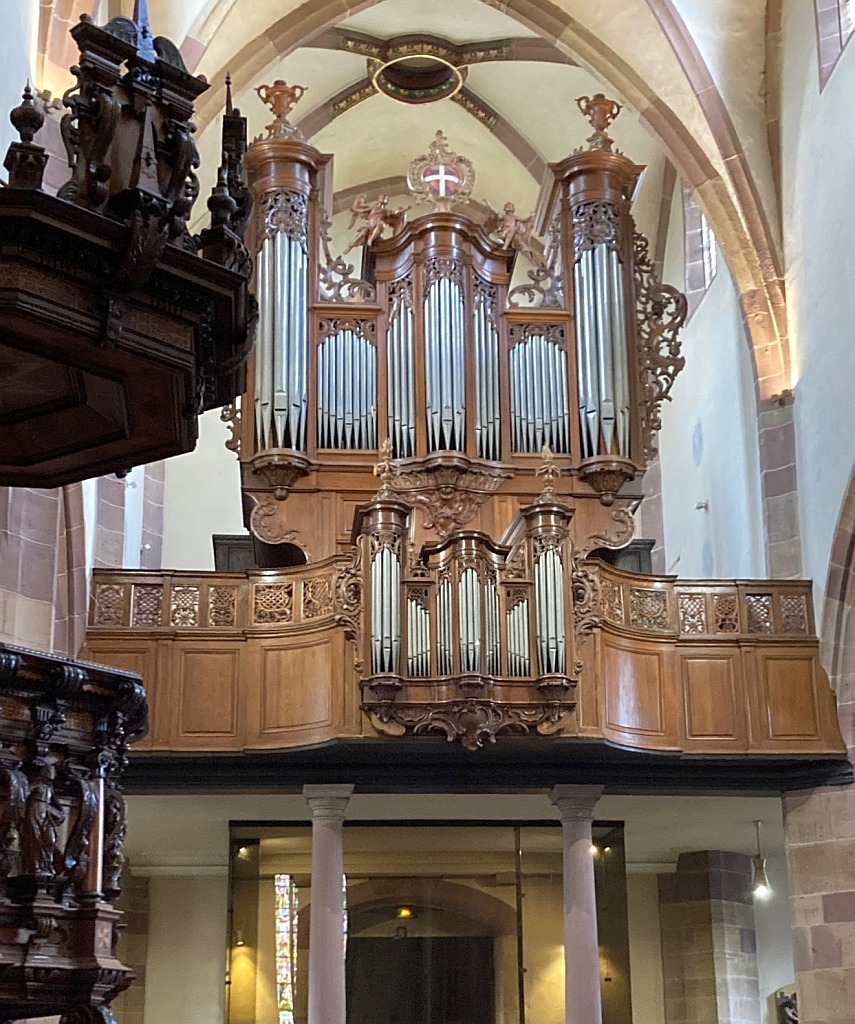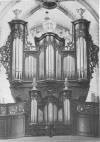Description complète d'orgue sélectionné

Photo: Anton Lukassen
Soultz-Haut-Rhin, France (Haut-Rhin (68)) - Église Saint Maurice
Commune: Soultz-Haut-Rhin
Région:Alsace
Adresse: 6 Place de l'Église, 68360, Soultz-Haut-Rhin
Description no.: 2005843.
Bâti par: Johann Andreas Silbermann (1750)
Données techniques
Composition
Hauptwerk: Bourdon 16', Montre 8', Bourdon 8', Prestant 4', Flûte 4', Nazard 2 2/3', Doublette 2', Tierce 1 3/5', Cornet 5 rangs, Fourniture 3 rangs, Cymbale 3 rangs, Trompette 8', Voix Humaine 8'.
Positiv: Bourdon 8', Prestant 4', Flûte 4', Nazard 2 2/3', Doublette 2', Tierce 1 3/5', Larigot 1 1/3', Carillon 1-2 rangs, Fourniture 3 rangs, Cromorne 8'.
Echo: Cornet, Voix Humaine 8'.
Pedal (C-c'): Flûte 16', Flûte 8', Trompette 8', Clairon 4'.

Photo: Anton Lukassen
Soultz-Haut-Rhin, France (Haut-Rhin (68)) - Église Saint Maurice
Commune: Soultz-Haut-Rhin
Région:Alsace
Adresse: 6 Place de l'Église, 68360, Soultz-Haut-Rhin
Description no.: 2005843.
Bâti par: Johann Andreas Silbermann (1750)
| Année | Facteur | Opus | Activité | 1750 | Johann Andreas Silbermann | orgue neuf | 1822 | Joseph Callinet | restauration et expansion | 1829 | Joseph Callinet | changer la disposition | 1852 | Joseph Callinet | changer la disposition | 1925 | Paul-Marie Koenig | conversion | 1932 | firma Georges Schwenkedel | activités différentes | 1970 | firma Georges Schwenkedel | reconstruction | 2011 | Richard Dott | restauration |
- In the years 1747-1750 Johann Andreas Silbermann built a three-manual organ for the parish church of Soultz. It was completed on October 24, 1750. In the years 1819-1822 Joseph Callinet worked on the organ. He expanded the manual compass to 51 keys, built a new Récit on a fourth manual with three stops (Flûte Traversière, Cornet 4 rangs and Hautbois), replaced the Voix Humaine of the Hauptwerk with a Clairon and the same stop of the Echo with a Trompette. In 1829 he installed a Bombarde 16' on the pedal and a Flûte Traversière 8' on the Echo. And finally in 1852 a Gambe 8' on the Hauptwerk and a Salicional 8' on the Positiv.
- More drastic was the renovation by Paul Koenig, organ maker in Caen, in 1925. He converted the organ into a three-manual organ with pneumatic action and a free-standing console. On September 20, 1925, Joseph Bonnet played the inaugurational concert. The work was of poor quality and had to be overhauled by Schwenkedel as early as 1932. In the years 1960-1970, Schwenkedel carried out a restoration, in which the original specification of Silbermann was reconstructed.
- After restoration work in the church building in the years 2008-2010, it was necessary to thoroughly clean the organ and immediately revise it technically. This work is performed by Richard Dott. On May 22, 2011, the organ could be put back into use. Olivier Vernet played the dedication concert.
Données techniques
| Nombre de registres par manuel | |
| - Hauptwerk | 13 |
| - Positiv | 10 |
| - Echo | 2 |
| - Pedal | 4 |
| Nombre de jeux total | 29 |
| Étendue des claviers | C-c''', Echo a-c''' |
| Étendue du pédalier | C-c' |
| Transmission des clés | Mechanical |
| Transmission des jeux | Mechanical |
| Sommier(s) | Slider chests |
Composition
Hauptwerk: Bourdon 16', Montre 8', Bourdon 8', Prestant 4', Flûte 4', Nazard 2 2/3', Doublette 2', Tierce 1 3/5', Cornet 5 rangs, Fourniture 3 rangs, Cymbale 3 rangs, Trompette 8', Voix Humaine 8'.
Positiv: Bourdon 8', Prestant 4', Flûte 4', Nazard 2 2/3', Doublette 2', Tierce 1 3/5', Larigot 1 1/3', Carillon 1-2 rangs, Fourniture 3 rangs, Cromorne 8'.
Echo: Cornet, Voix Humaine 8'.
Pedal (C-c'): Flûte 16', Flûte 8', Trompette 8', Clairon 4'.
| Références |
Historische Orgeln im Elsaß : 1489 - 1869 / P. Meyer-Siat. - München ; Zürich : Verlag Schnell & Steiner, 1983. - (98. Veröffentlichung der Gesellschaft der Orgelfreunde). |
| Enregistrements |
Splendeurs de l'orgue Français au XVIIIe siècle / OIivier Vernet. - Ligia Digital Lidi 0104031-95 (CD). - 1995. |
| Lièns |
https://www.itineraires-silbermann.org/soultz/ |
 |
 |
 |
